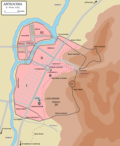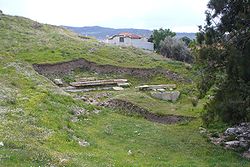Search results
Appearance
There is a page named "Madnasa" on Wikipedia
- Madnasa (Ancient Greek: Μάδνασα), or Medmasa (Μέδμασα), also known as Medmasus or Medmasos (Μέδμασος), was a town in ancient Caria, at the Myndos Peninsula...4 KB (405 words) - 22:13, 28 October 2024
- (Makseem Agorky) Donjuan Mawta Bela Goubour Tartuffe Al Zeer Salem Al Madnasa Hekayat Hob Al Masa Al Mutafaela Oedipus Al Mufatish Al Am Haram Mali Al...14 KB (1,441 words) - 13:00, 12 March 2025
- Leucae Leucophrys Limantepe Lobolda Loryma Lunda Lydae Lyrna Lysimachia Madnasa Maeandropolis Magnesia ad Sipylum Magnesia on the Maeander Maiboza Maionia...88 KB (9,830 words) - 11:36, 6 April 2025
- Leucae Leucophrys Limantepe Lobolda Loryma Lunda Lydae Lyrna Lysimachia Madnasa Maeandropolis Magnesia ad Sipylum Magnesia on the Maeander Maiboza Maionia...68 KB (8,508 words) - 00:53, 30 March 2025
- Leucae Leucophrys Limantepe Lobolda Loryma Lunda Lydae Lyrna Lysimachia Madnasa Maeandropolis Magnesia ad Sipylum Magnesia on the Maeander Maiboza Maionia...63 KB (7,272 words) - 13:03, 10 March 2025
- Leucae Leucophrys Limantepe Lobolda Loryma Lunda Lydae Lyrna Lysimachia Madnasa Maeandropolis Magnesia ad Sipylum Magnesia on the Maeander Maiboza Maionia...23 KB (2,553 words) - 13:02, 25 March 2025
- Leucae Leucophrys Limantepe Lobolda Loryma Lunda Lydae Lyrna Lysimachia Madnasa Maeandropolis Magnesia ad Sipylum Magnesia on the Maeander Maiboza Maionia...30 KB (3,455 words) - 16:34, 23 March 2025
- Leucae Leucophrys Limantepe Lobolda Loryma Lunda Lydae Lyrna Lysimachia Madnasa Maeandropolis Magnesia ad Sipylum Magnesia on the Maeander Maiboza Maionia...35 KB (3,831 words) - 07:49, 27 March 2025
- Leucae Leucophrys Limantepe Lobolda Loryma Lunda Lydae Lyrna Lysimachia Madnasa Maeandropolis Magnesia ad Sipylum Magnesia on the Maeander Maiboza Maionia...14 KB (1,464 words) - 09:40, 19 March 2025
- Leucae Leucophrys Limantepe Lobolda Loryma Lunda Lydae Lyrna Lysimachia Madnasa Maeandropolis Magnesia ad Sipylum Magnesia on the Maeander Maiboza Maionia...32 KB (3,625 words) - 02:57, 14 January 2025
- Leucae Leucophrys Limantepe Lobolda Loryma Lunda Lydae Lyrna Lysimachia Madnasa Maeandropolis Magnesia ad Sipylum Magnesia on the Maeander Maiboza Maionia...15 KB (1,360 words) - 14:40, 6 March 2025
- Leucae Leucophrys Limantepe Lobolda Loryma Lunda Lydae Lyrna Lysimachia Madnasa Maeandropolis Magnesia ad Sipylum Magnesia on the Maeander Maiboza Maionia...17 KB (1,866 words) - 19:14, 6 March 2025
- Leucae Leucophrys Limantepe Lobolda Loryma Lunda Lydae Lyrna Lysimachia Madnasa Maeandropolis Magnesia ad Sipylum Magnesia on the Maeander Maiboza Maionia...41 KB (4,835 words) - 15:40, 8 April 2025
- Leucae Leucophrys Limantepe Lobolda Loryma Lunda Lydae Lyrna Lysimachia Madnasa Maeandropolis Magnesia ad Sipylum Magnesia on the Maeander Maiboza Maionia...7 KB (736 words) - 02:12, 28 March 2025
- Leucae Leucophrys Limantepe Lobolda Loryma Lunda Lydae Lyrna Lysimachia Madnasa Maeandropolis Magnesia ad Sipylum Magnesia on the Maeander Maiboza Maionia...22 KB (1,781 words) - 05:35, 31 March 2025
- Leucae Leucophrys Limantepe Lobolda Loryma Lunda Lydae Lyrna Lysimachia Madnasa Maeandropolis Magnesia ad Sipylum Magnesia on the Maeander Maiboza Maionia...22 KB (1,959 words) - 06:04, 28 March 2025
- Leucae Leucophrys Limantepe Lobolda Loryma Lunda Lydae Lyrna Lysimachia Madnasa Maeandropolis Magnesia ad Sipylum Magnesia on the Maeander Maiboza Maionia...41 KB (4,678 words) - 01:19, 24 March 2025
- Leucae Leucophrys Limantepe Lobolda Loryma Lunda Lydae Lyrna Lysimachia Madnasa Maeandropolis Magnesia ad Sipylum Magnesia on the Maeander Maiboza Maionia...28 KB (3,125 words) - 17:39, 26 February 2025
- Leucae Leucophrys Limantepe Lobolda Loryma Lunda Lydae Lyrna Lysimachia Madnasa Maeandropolis Magnesia ad Sipylum Magnesia on the Maeander Maiboza Maionia...25 KB (2,534 words) - 12:02, 5 February 2025
- Leucae Leucophrys Limantepe Lobolda Loryma Lunda Lydae Lyrna Lysimachia Madnasa Maeandropolis Magnesia ad Sipylum Magnesia on the Maeander Maiboza Maionia...18 KB (1,932 words) - 10:08, 27 March 2025



















